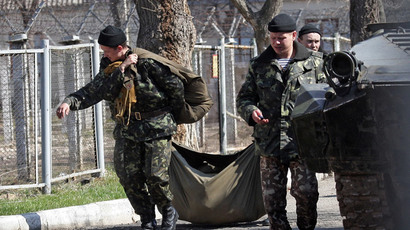Diver defense: Crimean military dolphins now train with Russian Navy
The combat dolphins of Crimea will now serve the Russian Black Sea Fleet. They will assist divers in searching for sunken ships and lost underwater equipment, Russian naval forces said.
The research facility called Kazachya Bukhta, not far from Sevastopol, which explores the military use of common bottlenose dolphins, the best-known member of the dolphin family, was founded back in 1965.
The Soviet Navy used sea mammals to patrol the area, rescue lost naval swimmers or locate underwater mines. Some of them even were able to seek and destroy submarines using kamikaze methods.
However, the dolphins were also used for less “aggressive” purposes, trained for underwater search for lost military equipment.
The Crimean military dolphins belonged to Ukraine from the fall of the USSR up to March 2014, when after Crimea’s inclusion to Russia they began operating under the Russian flag.
They could now prove to be very useful to the Russian Navy, but for peaceful tasks, believes Captain Yury Plyachenko, the head of the counter-sabotage forces of the Black Sea Fleet from 1988-1992.
First, the cetaceans can inspect the underwater pipes including gas pipelines and cable systems. The dolphins can also help Russian Ministry of Emergency Situations to retrieve lost objects underwater.
Dolphins will help the Russian navy as they can search for lost torpedoes and shipwrecks in the training areas, he said.

“There are some areas which are difficult, or even impossible, to reach for divers. But that’s what the first human sea friends are for,” says Plyachenko.
“The time of the divers underwater is limited, but not for the dolphins,” he adds.
Earlier, the sea mammals were used only for military purposes such as patrolling open waters or attaching buoys to items of military interest, such as mines on the sea floor or even combatting enemy scuba divers.
However, according to Plyachenko the dolphins can no longer be used to carry out such tasks.
“The world has changed. There is no need to assign the dolphins with any combat tasks as it’s no longer effective,” says the head of the counter-sabotage forces.
“Using dolphins for military reasons is inhumane, it will harm the world’s ecology as our rivals might want to kill them,” he adds.

Meanwhile, training the guard- dolphins will also involve high costs, believes Plyachenko. That’s why the Russian Navy won’t use the dolphins in patrolling the areas.
“There is no particular image of the terrorist nowadays. Today he has one face, tomorrow another. And the dolphin only sees what he is taught to,” says Plyachenko, adding that the dolphin only uses the behavioral and frequency characteristics, which turn out to be ineffective.
Ruptly news agency footage shows how the dolphins are trained wearing special equipment. The trainers give a dolphin orders using body language and the sea mammal goes to work. The dolphin detects an object and then issues a signal with the help of special equipment attached to it. A diver then descends to the detected place and picks the object.
Incidentally, gamers of the world might recognize the dolphins from the popular real time strategy game Command & Conquer: Red Alert 3.
However, it is the Allied, and not Soviet forces who use the marine mammals as scouts and low-cost defense against enemy ships in the game.















